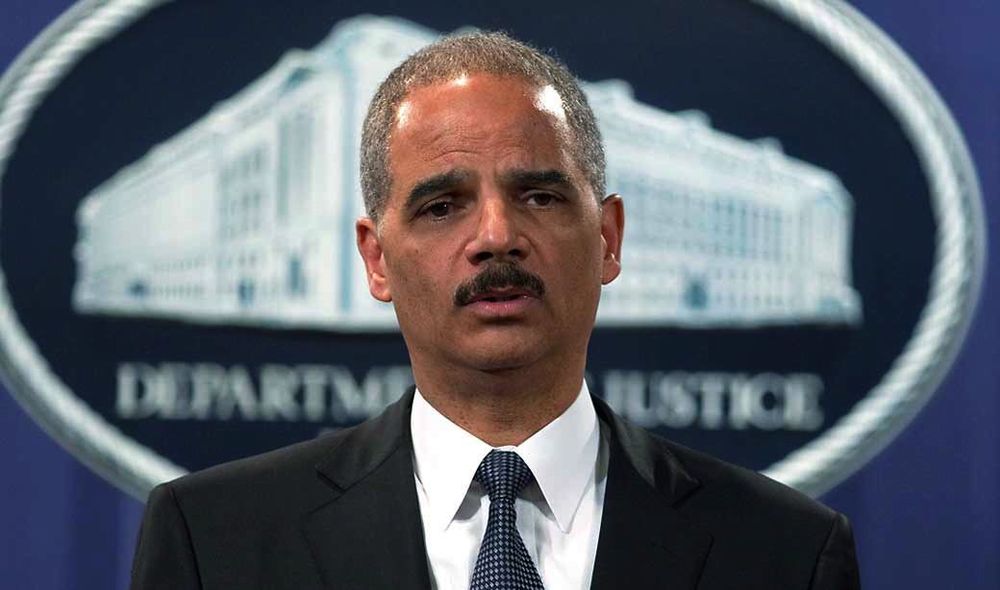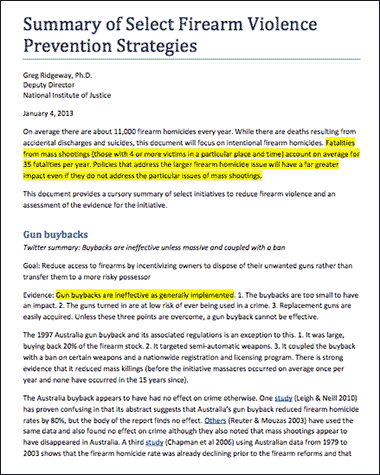Results 1 to 1 of 1
Thread Information
Users Browsing this Thread
There are currently 1 users browsing this thread. (0 members and 1 guests)
-
10-13-2015, 10:31 AM #1Senior Member

- Join Date
- Jul 2014
- Posts
- 594
NRA OBTAINED DOJ Memo calling for national gun registration and confiscation.
"Tear Down the Constitution/Bill of Rights" - Lame Duck President
Leaked DOJ Memo: Outlaw and Confiscate All Guns...


The National Rifle Association has obtained a Department of Justice memo calling for national gun registration and confiscation. The nine page “cursory summary” on current gun control initiatives was not officially released by the Obama administration.
The DOJ memo (downloadable here as a PDF) states the administration “believes that a gun ban will not work without mandatory gun confiscation,” according to the NRA, and thinks universal background checks “won’t work without requiring national gun registration.” Obama has yet to publicly support national registration or firearms confiscation, although the memo reveals his administration is moving in that direction.
The memo stands in stark contrast to the administration’s public stance on so-called gun control. White House spokesman Jay Carney said last month that laws proposed by Obama would not “take away a gun from a single law-abiding American.”
The NRA declined to explain how it obtained the document. The memo was written by the acting director of the Justice Department’s National Institute of Justice, Greg Ridgeway. It is dated January 4, two weeks before Obama mounted his attack on the Second Amendment following the Sandy Hook massacre. Ridgeway came to the Justice Department from the RAND corporation.
The memo says universal background checks on firearms purchases may help the government push to control and eventually outlaw firearms, but it would lead to an increase in illegally purchased guns.


DOJ memo states: “Buybacks are ineffective unless massive and coupled with a ban.”
It pointed out that banning high capacity ammunition clips would be ineffective due to the fact there is a large number of them already in circulation.
A Justice Department official said the memo is an unfinished review of gun violence research and does not represent administration policy.
The DOJ memo arrived a few weeks prior to a letter sent out by the Department of Veterans Affairs. “A determination of incompetency will prohibit you from purchasing, possessing, receiving, or transporting a firearm or ammunition,” the sent to military veterans states. “If you knowingly violate any of these prohibitions, you may be fined, imprisoned, or both pursuant to the Brady Handgun Violence Prevention Act, Pub.L.No. 103-159, as implemented at 18, United States Code 924(a)(2).”
“US veterans are receiving letters from the government informing them that they are disabled and not allowed to own, purchase or possess a firearm. If the veteran does decide to purchase a firearm he will by fined, imprisoned or both,” the Gateway Pundit remarked. Continue reading by Kurt Nimmo via Infowars...
http://www.redflagnews.com/headlines...scate-all-guns
<font size="2">
Summary of Select Firearm Violence
Prevention Strategies
Greg Ridgeway, Ph.D.
Deputy Director
National Institute of Justice
January 4, 2013
On average there are about 11,000 firearm homicides every year. While there are deaths resulting from
accidental discharges and suicides, this document will focus on intentional firearm homicides.
Fatalities
from mass shootings (those with 4 or more victim
s in a particular place and time) account on average for
35 fatalities per year. Policies that address the larger firearm homicide issue will have a far greater
impact even if they do not address the particular issues of mass shootings.
This document provi
des a cursory summary of select initiatives to reduce firearm violence and an
assessment of the evidence for the initiative.
Gun buybacks
Twitter summary: Buybacks are ineffective unless massive and coupled with a ban
Goal: Reduce access to firearms by inc
entivizing owners to dispose of their unwanted guns rather than
transfer them to a more risky possessor
Evidence:
Gun buybacks are ineffective as generally implemented
. 1. The buybacks are too small to have
an impact. 2. The guns turned in are at low risk
of ever being used in a crime. 3. Replacement guns are
easily acquired. Unless these three points are overcome, a gun buyback cannot be effective.
The 1997 Australia gun buyback and its associated regulations is an exception to this. 1. It was large,
buyin
g back 20% of the firearm stock. 2. It targeted semi
-
automatic weapons. 3. It coupled the buyback
with a ban on certain weapons and a nationwide registration and licensing program. There is strong
evidence that it reduced mass killings (before the initiati
ve massacres occurred on average once per
year and none have occurred in the 15 years since).
The Australia buyback appears to have had no effect on crime otherwise. One
study
(Leigh & Neill 201
0)
has proven confusing in that its abstract suggests that Australia’s gun buyback reduced firearm homicide
rates by 80%, but the body of the report finds no effect.
Others
(Reute
r & Mouzas 2003) have used the
same data and also found no effect on crime although they also noted that mass shootings appear to
have disappeared in Australia. A third
study
(Chapman et al
2006) using Australian data from 1979 to
2003 shows that the firearm homicide rate was already declining prior to the firearm reforms and that
there is no evidence that the new legislation accelerated the declines. This remains true when data
through 2007
are added to the analysis (conducted by G. Ridgeway on 1/3/2013 at NI
http://static.infowars.com/2013/02/i...olicy-memo.pdf
Similar Threads
-
In South Africa – Gun Registration Has Led to Gun Confiscation in Two Short Years
By Newmexican in forum Other Topics News and IssuesReplies: 1Last Post: 11-15-2015, 10:54 AM -
Obama Lays Groundwork for Universal Gun Registration - Eventual Confiscation
By HAPPY2BME in forum General DiscussionReplies: 2Last Post: 04-11-2014, 09:46 AM -
DOJ internal memo confirms Obama plan for gun confiscation
By Newmexican in forum General DiscussionReplies: 1Last Post: 11-22-2013, 01:48 PM -
Universal Background Check: Registration and Confiscation
By AirborneSapper7 in forum Other Topics News and IssuesReplies: 0Last Post: 03-05-2013, 11:18 PM -
Obama DOJ Memo: A National Gun Registration & Mandatory Confiscation Agenda
By AirborneSapper7 in forum Other Topics News and IssuesReplies: 1Last Post: 02-28-2013, 08:43 PM


 LinkBack URL
LinkBack URL About LinkBacks
About LinkBacks




 Reply With Quote
Reply With Quote

Illegal immigration is costing American hospitals billions of...
04-27-2024, 07:55 PM in General Discussion